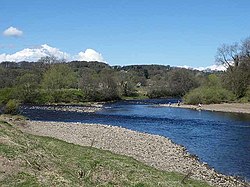Warden, Northumberland: Difference between revisions
Created page with "{{Infobox town |name=Warden |county=Northumberland |picture=Watersmeet - geograph.org.uk - 1254483.jpg |picture caption=The North Tyne meets the South Tyne (left) |os grid ref..." |
No edit summary |
||
| Line 33: | Line 33: | ||
|isbn=0-946098-36-0 | |isbn=0-946098-36-0 | ||
}}</ref> | }}</ref> | ||
==Parish church== | ==Parish church== | ||
| Line 59: | Line 55: | ||
There is also a Methodist church in the village, built in 1851. In appearance it resembles a barn rather than an ecclesiastical edifice.<ref name=Rowland/> | There is also a Methodist church in the village, built in 1851. In appearance it resembles a barn rather than an ecclesiastical edifice.<ref name=Rowland/> | ||
==Landscape about the village | ==Landscape about the village== | ||
From Warden one can see eastwards among the trees which rise on the northern slope of the valley the spire of the Church of St John Lee on high ground at [[Acomb, Northumberland|Acomb]]. It commemorates the hermitage of St John of Beverley, sometime bishop of Hexham (689-705). The present church is no older than 1818-85.<ref name="Fraser"/> | From Warden one can see eastwards among the trees which rise on the northern slope of the valley the spire of the Church of St John Lee on high ground at [[Acomb, Northumberland|Acomb]]. It commemorates the hermitage of St John of Beverley, sometime bishop of Hexham (689-705). The present church is no older than 1818-85.<ref name="Fraser"/> | ||
Revision as of 21:23, 19 November 2015
| Warden | |
| Northumberland | |
|---|---|
 The North Tyne meets the South Tyne (left) | |
| Location | |
| Grid reference: | NY915665 |
| Location: | 54°59’35"N, 2°8’2"W |
| Data | |
| Population: | 603 (2011) |
| Post town: | Hexham |
| Postcode: | NE46 |
| Local Government | |
| Council: | Northumberland |
| Parliamentary constituency: |
Hexham |
Warden is a village in Northumberland about two miles west of Hexham.
The two rivers the North Tyne and South Tyne meet near the village of Warden to become the River Tyne. There is a pleasant walk from the Boatside Inn, once simply the Boat Inn, along the bank of the South Tyne to the meeting of the waters.
The Boat Inn was formerly the place of a ferry until the toll bridge was built across the river. The toll house still stands, but the old bridge was replaced in 1904 by a new bridge.
The Newcastle and Carlisle Railway crosses the river here.
Warden is dominated by the old motte, now tree covered, and higher still are the earthworks of a prehistoric fort.[1]
Parish church
The parish church is dedicated to St Michael, and has a fine upstanding Anglo Saxon tower dating back to the eleventh century, and built of Roman stone: one of those slender Anglo-Danish towers which are a feature of the Tyne valley. The body of the church is later, from some time after the Norman conquest. There are indications are that there was a church earlier than the tower.
The tower arch is built of Roman material, probably from Chesters. Transepts were added in the thirteenth century making the church cruciform in shape. There were alterations in the eighteenth century, and the chancel was rebuilt in 1889. In the chancel is a Norman grave-cover that is the best of its kind in the county. Its shape and tile decoration symbolise a house of the dead.[1]
The churchyard appears oval in shape, which reinforces the notion of the great age of these Tyne parish centres. There are a number of incised grave covers in the porch, and a Roman altar that has been carved with Saxon knot-work. It has been split and reversed, possibly "to empty out the devils." It has been claimed to be a 'market cross' but there is no record of a market here nor any likelihood that there was with Hexham market so close by: the Roman-Saxon stone may be instead one of the boundary crosses marking the sanctuary limits or 'frith' of St Wilfrid's church at Hexham. The socket of one such cross survived near the road at Acomb.[2]
An 18th century horsing-stool stands at the church-gate.[1]
There is also a Methodist church in the village, built in 1851. In appearance it resembles a barn rather than an ecclesiastical edifice.[1]
Landscape about the village
From Warden one can see eastwards among the trees which rise on the northern slope of the valley the spire of the Church of St John Lee on high ground at Acomb. It commemorates the hermitage of St John of Beverley, sometime bishop of Hexham (689-705). The present church is no older than 1818-85.[2]
On the hillside above the village, a path leads to a large fortified Iron Age camp crowning the hill, which gives a fine outlook over the surrounding country.[3]
Economy
Warden is situated on a triangle of land between the two Tynes. It had a water mill on the North Tyne and a paper mill on the South Tyne, which started in 1763 and still exists. A century ago a visitor described how the rags were converted into beautiful white paper. The mill employed 63 hands.[1]
Outside links
References
- ↑ 1.0 1.1 1.2 1.3 1.4 Rowland, T. H. (1994). Waters of Tyne (Reprint ed.). Warkworth, Northumberland, England: Sandhill Press Ltd. ISBN 0-946098-36-0.
- ↑ 2.0 2.1 Fraser, Constance; Emsley, Kenneth (1989). Northumbria. Chichester, Sussex: Phillimore & Co. Ltd. ISBN 0-85033-723-2.
- ↑ Hugill, Robert: Road Guide to Northumberland and The Border, Andrew Reid & Company, Limited, 1931